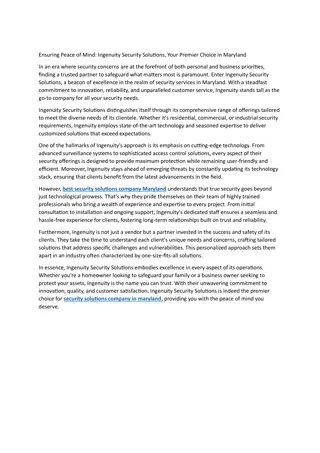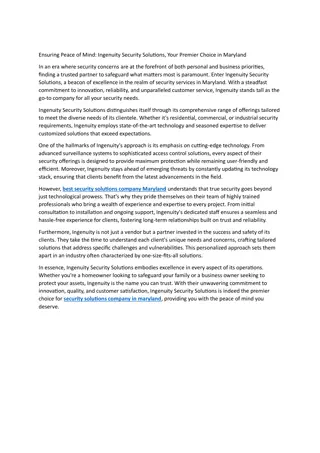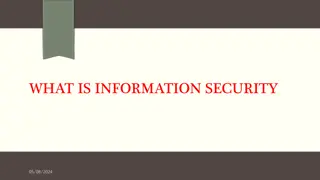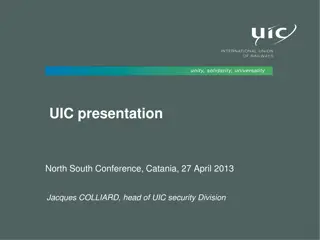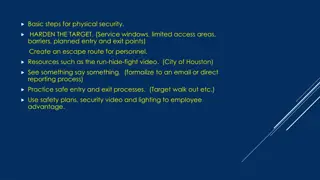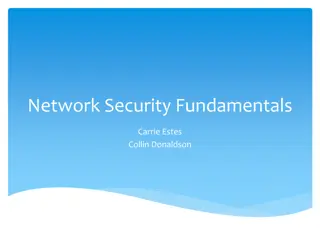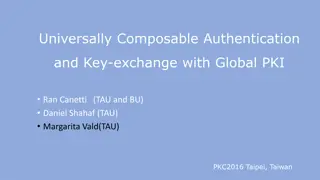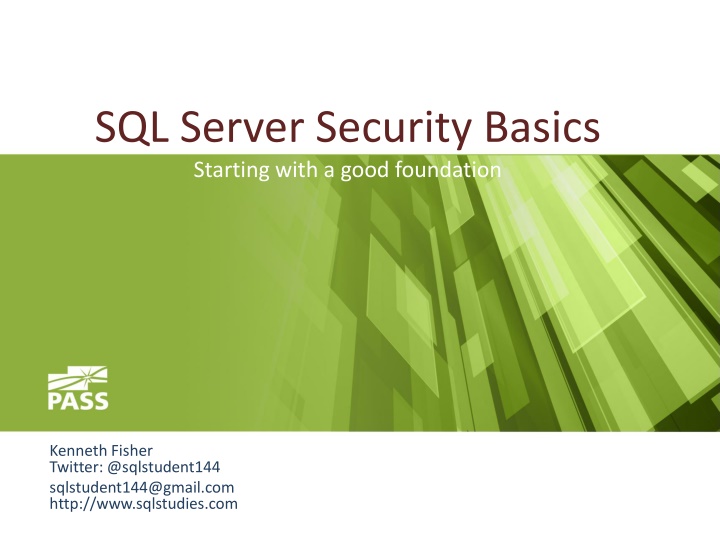
Foundations of SQL Server Security Basics
Dive into the essential aspects of SQL Server security with a solid foundation. Understand the importance, complexities, and basics of security to safeguard against identity theft, data breaches, and common mistakes. Explore definitions of principals, securables, permissions, and best practices within SQL Server security.
Download Presentation

Please find below an Image/Link to download the presentation.
The content on the website is provided AS IS for your information and personal use only. It may not be sold, licensed, or shared on other websites without obtaining consent from the author. If you encounter any issues during the download, it is possible that the publisher has removed the file from their server.
You are allowed to download the files provided on this website for personal or commercial use, subject to the condition that they are used lawfully. All files are the property of their respective owners.
The content on the website is provided AS IS for your information and personal use only. It may not be sold, licensed, or shared on other websites without obtaining consent from the author.
E N D
Presentation Transcript
SQL Server Security Basics Starting with a good foundation Kenneth Fisher Twitter: @sqlstudent144 sqlstudent144@gmail.com http://www.sqlstudies.com
Why are we here? What security isn't It's not high profile like HA, DR, and performance tuning. There is no praise, only blame. What it is Typically very complex. It s very easy to make mistakes.
Why are we here? Identity theft More than 10 million victims a year. Not just financial identity theft but medical as well. Data breaches Impossible to accurately know but from one source more than half a billion individual records lost in 2014.
Why are we here? Why the basics? We all start out at the beginning. It s important to have a good foundation in any subject. A large portion of our work revolves around the basics. We tend to cause ourselves extra work if we don't understand the basics.
What are we doing? Definitions: What are Principals, Securables and Permissions? Where can we find everything? (using the GUI) Some best practices.
Definitions Principals Securables Permissions
Permissions A permission is what the principal is allowed to do to the securable. SPs & Functions EXECUTE Tables & Views SELECT INSERT UPDATE DELETE Database CONNECT BACKUP CREATE PROCEDURE VIEW DATABASE STATE SPs, Functions & Views VIEW DEFINITION
Securables A securable is an object that a principal wants access to. Database Schema Schema Stored Procedure Function View Table Column Column
Securables A securable is an object that a principal wants access to. Instance
Principals A principal is something requesting permissions to a securable. Database Server Windows login SQL login Server role Login mapped to a certificate User mapped to an asymmetric key Windows group Application role Login mapped to an asymmetric key Windows user SQL user Windows group User mapped to a certificate Database role
Principals A principal is something requesting permissions to a securable. Server Database Logins Users SQL user Roles SQL login Server role AD\Windows login Database role AD\Windows login AD\Windows group Application role AD\Windows group User mapped to a certificate Login mapped to a certificate Login mapped to an asymmetric key User mapped to an asymmetric key
Principals A role is a special type of principal that is designed to contain other principals and transfer permissions to them. User defined roles Roles created by a user and can be granted permissions. User defined server roles are new as of SQL Server 2012. Built in roles Server and Database level roles that come with SQL Server and can t be granted or revoked permissions.
Tying it all together Unsurprisingly all of this data is stored in system views. Database Instance sys.database_principals sys.database_permissions sys.database_role_members sys.server_principals sys.server_permissions sys.server_role_members These six contain just the core data. There are quite a few more views with a variety of additional information!
Tying it all together How are server principals and database principals related? SID 0x014EA8886B841C4CA1F7ED32489BBF62 SQL Login Principal_ID Name SID 0x010500000000000515000000AA70DE8DE2 4F4D68F572D91623FF0300 Server Principals Database Principals 0x010500000000000515000000AA70DE8DE2 4F4D68F572D916EB8C0100 AD Login AD Group 0x01060000000000090100000069EE6684FF 55FDC676DE368D07C2C200FE155810 Certificate
Tying it all together Orphaned Users SID 0x014EA8886B841C4CA1F7ED32489BBF62 SQL Login Server Principals Database Principals 0x010500000000000515000000AA70DE8DE2 4F4D68F572D916EB8C0100 AD Login 0x010500000000000515000000AA70DE8DE2 4F4D68F572D91623FF0300 AD Group 0x01060000000000090100000069EE6684FF 55FDC676DE368D07C2C200FE155810 Certificate
Tying it all together Orphaned Users Windows Authenticated Server A Server B CREATE LOGIN [Domain\Dopey] FROM WINDOWS Logins Logins Users Users
Tying it all together Orphaned Users SQL Authenticated Server A Server B CREATE LOGIN Dopey WITH PASSWORD = 'MyPass'; Logins Logins EXEC sp_change_users_login 'auto_fix','DOPEY'; or ALTER USER Dopey WITH LOGIN = Dopey; Users Users
Tying it all together Orphaned Users SQL Authenticated Server A Server B CREATE LOGIN Dopey WITH PASSWORD = 'MyPass'; Logins Logins EXEC sp_change_users_login 'auto_fix','DOPEY'; or ALTER USER Dopey WITH LOGIN = Dopey; Users Users
Tying it all together Orphaned Users SQL Authenticated Server A Server B CREATE LOGIN Dopey WITH PASSWORD = 'MyPass'; Logins Logins EXEC sp_change_users_login 'auto_fix','DOPEY'; or ALTER USER Dopey WITH LOGIN = Dopey; Users Users
Tying it all together Orphaned Users SQL Authenticated Server A Server B CREATE LOGIN Dopey WITH PASSWORD = 'MyPass', SID = 0x014EA8886B841C4CA 1F7ED32489BBF62 Logins Logins Users Users
Tying it all together Orphaned Users Exceptions Roles Server and database roles have no relation to each other. Contained Databases The database principals in a contained database have all of the information needed to connect to the server and database. Server A Server B Server A Login Login User User Roles <> Roles
Tying it all together How do we apply a permission to a principal? DENY GRANT A permission cannot be allowed. Allow a permission REVOKE Remove a GRANT or DENY.
Administrative Principals and Permissions There are six special principals/permissions. These are the super users and deserve special attention. Each of these principals and permissions have complete control over their associated securable. Single User Role Permission Instance sa sysadmin control server Database dbo db_owner control database
Where can we find everything? Most people start out using the GUI to find what permissions a principal has. But where in the GUI is everything? Principals Securables
Where can we find everything? DEMO Finding the security data in SSMS object explorer.
Best Practices! Least Maintenance Least Surface Area Least Privileges
Best Practices! Least Maintenance Make your life as easy as possible. Don t make permissions more granular than you have to. (Don t grant at a table level if a Schema or even better the DB level will work) Using Roles and AD/Windows groups. Be consistent.
Best Practices! Least Surface Area Reduce the number of places an attack can come from. Don t install it if you won t be using it, or if you do then disable it. (SSIS, SSAS etc.) Don t create extra databases in production. (AdventureWorks for example) Disable unused SQL Server Protocols. (TCP\IP, Named Pipes, VIA, shared memory)
Best Practices! Least Privilege If they don't need to do it don't let them. Adding a developer to the db_Owner role, even on a development database. Grant permissions to views, SPs etc. rather than the underlying tables. Granting permissions at lowest level possible. (Don t grant at a DB level if a Schema or even Object level will work)
Best Practices! Security is all give and take. Security is a balance between granting sufficient permissions to allow users to get their job done and limiting those permissions to avoid mistakes and discourage malicious activities. To make security workable you also have to balance the risks of granting too many permissions against the maintenance cost of granting permissions at the minimum level.
It's a big scary world out there. Physical Security Network Security Server Security SQL Server Security
Thank You! Questions Kenneth Fisher sqlstudent144@gmail.com http://sqlstudies.com Twitter: @sqlstudent144










